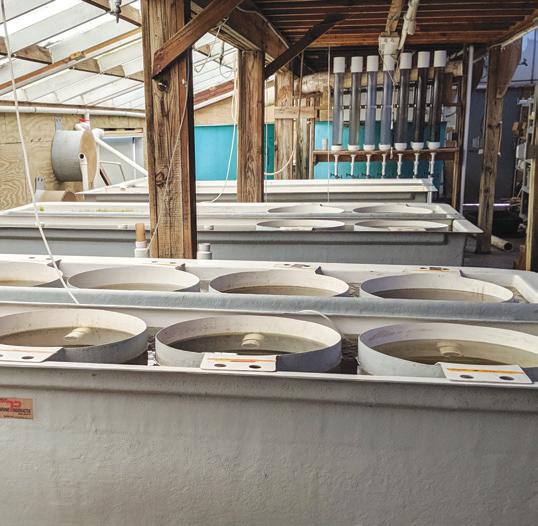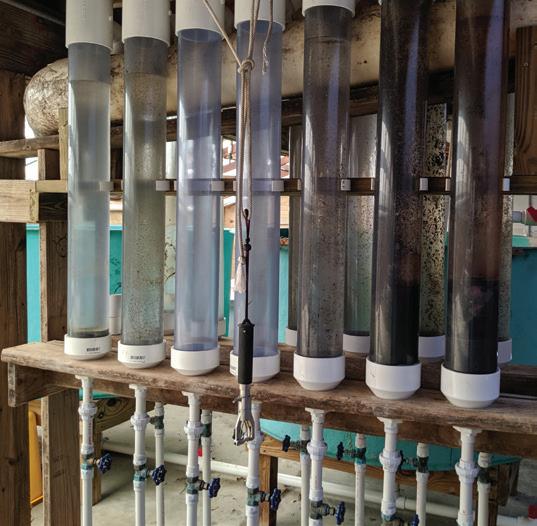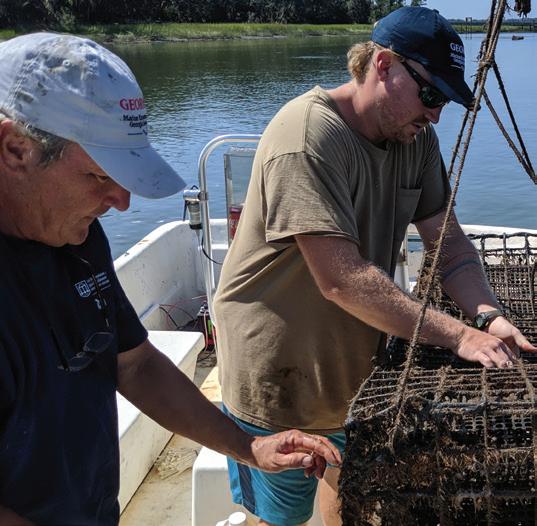
5 minute read
Positioned For Growth
Georgia's Oyster Farming Industry
Article and Photos
Advertisement
By Dan Foulds
On a fine fall morning I arrived at the Shellfish Research Lab on Skidaway Island, to learn more about their project to create an entire Georgia industry from scratch. The lab is part of the University of Georgia Marine Extension and Georgia Sea Grant. As I spoke with Emily Kenworthy, the public relations coordinator, it quickly became apparent that I have much to learn about oyster farming and mariculture aquaculture in a marine environment.
In the same manner that states and universities send agricultural extension agents into the field to help farmers become more successful and improve their farming practices, so the University of Georgia provides marine extension specialists to help shellfish farmers be more successful at growing and harvesting oysters, clams and other types of seafood. For the past few years, the mission of the Shellfish Lab has been focused on growing single oysters and reviving the once-thriving oyster industry in Georgia. Hatchery specialists produce oyster seed, or baby oysters, that are sold to shellfish farmers in coastal Ga. and S.C. Shellfish farmers can purchase bottom leases – essentially leasing sections of creeks or rivers – to grow their oysters.
While the commercial harvesting of wild oysters in Georgia is relatively modest and is limited to collecting the bivalve mollusks from wild beds, reefs, or rakes, oyster aquaculture could be a much larger industry in the very near future, thanks to the activities going on at Skidaway.
A bill passed earlier this year in the Legislature provides for the sale of permits to farmers via annual bottom leases in one acre increments. Leases will go for $50 per acre and there will be a fee of one dollar per cage. The legislation came with controversy over the details, which are being worked out by a stakeholder’s advisory group.
Farming oysters is a multi-step process. The first steps take place in the UGA Oyster Hatchery where researchers spawn oysters, creating larvae that eventually grow into single baby oysters. Upwelling water systems provide aerated water to the juveniles which are kept in place with fine-mesh screens.
As the oysters grow they are moved to progressively larger containment equipment and eventually they are either sold to farmers or used for research at the lab, including the use of bottom cages and floating cages to grow the oysters out. The floating cages lay either just under the surface, or when flipped on top of their floats, just over it. Cages must be flipped regularly, allowing the oysters to be exposed, to protect them from becoming habitat for free-swimming wild spat (oyster larvae) searching for a surface on which to attach and grow. Whereas a perfectly formed “single” farm-raised oyster might fetch seventy to ninety cents at market, one that has been colonized by wild spat and turned into a “cluster” will only fetch about a dime. Flipping the cages also prevents other marine growth from taking hold, and keeps the oyster shells clean.
Down at the dock, I met Rob Hein and John Pelli, the aquaculture extension specialists based at the Shellfish Research Lab on the oysterculture project for the benefit of this developing industry. These guys are where the rubber meets the road, so-tospeak, and the farmed oysters, once they are placed in the natural environment, are their babies.
The task that day was to flip the cages at their research sites in the Skidaway River and Wassaw Sound. After they drop me off later, they’ll return to the cages and painstakingly count and measure every oyster in every bag in every cage. They’ll also count and remove oysters that have died – hopefully a small percentage. There are subtle variations in how the oysters are prepared and placed, such as some of the cages situated on the bottom. The objective is to determine which growing methods yield the best results, and they’re using the scientific data to derive results.
Rob is a native of Athens, Ga., and a graduate of UGA with a degree in ecology. His background includes middle-school teaching, and he confides that while teaching was okay he missed doing research and was glad to get a glowing recommendation from a former colleague which led to a job at the lab. Rob is very knowledgeable and explains as much of oysterculture as I can digest. He explained diploid and triploid oysters in the cages we worked that day. Triploids cannot reproduce, so do not spend energy on creating sperm or eggs for reproduction. He explained that triploids generally grow faster and therefore can go to market sooner and be more profitable. The team wants to learn more about how they do in Georgia waters.
As we ride out the river and I listen to Rob and John, I begin to realize that there’s a whole world of oyster consumption beyond anything I’ve experienced. My oyster eating and knowledge is limited to the typical lowcountry backyard oyster roast. All over America, people go to restaurants and sample oysters from every coast, with each region of origin having its own tastes and characteristics. Rob explained to me that an oyster from a specific region might be described as “a well-balanced combination of sweetness at the start and a buttery soft brine finish.” Who knew oysters could be a component of fine dining? Not me, but I’m excited about the prospect of eating my way to better understanding!
I can imagine tucking into a sampler platter with oysters from east, south, and west. No cracker, no cocktail sauce, just the oyster speaking for itself. Getting hungry yet?
One notable aspect of oyster aficionados is their willingness to spend real money for the objects of their desire. That translates into opportunity for those who are willing to dive in to the business. And that is coming soon. For now, specialists at the lab are learning how to produce oysters with the ideal shape, shell, taste, and texture, and then to pass on that knowledge – and the spat – to replicate the production on a large scale.
John Pelli is a former Union Camp managing engineer who has traveled all over the world. Of the three of us on the boat, he is also the only person who has actually worked in commercial shellfish farming in Georgia, having once operated a clam farm in Wassaw Sound. His background makes him an obvious choice for extending expertise and practical skills to oyster growers working to get their farms up and running. When I asked him if he’s any kin to my friend and boat mechanic Terry Pelli, he laughed and says, “he’s my brother.”
We pulled up to the cages and as Rob and John began to flip them, I could see it was hard work. Our boat had a winch motor and swing arm to provide mechanical assistance, but as Rob pointed out, flipping 500 cages would be tough. If the water’s the right depth you can flip baskets while standing in it, and John is working on other forms of mechanical assistance as part of the project. Even so, like shrimping and crabbing, oyster farming is hard, physical work.
As the legislation to permit oyster farming was being created, there were differences of opinion as to how much of the year should be allocated to harvesting: cooler months only, or all year long. Another point of contention concerned how bottom leases should be distributed: by lottery open to all, or Georgia residents only, or to the highest bidder. While the extension specialists are undoubtedly aware of these issues, they aren’t concerned with them or with the results. Their only goal is to study aquaculture methods that are sustainable, repeatable, and predictable. All Georgians will benefit from their labors, and I am grateful for what they and the rest of the team at the Shellfish Research Lab are doing.
Want to learn more about the work at the Shellfish Research Lab and help support their efforts to grow the industry? You can by attending Oyster Roast for a Reason on Nov. 17 at the UGA Aquarium on Skidaway Island. The event will feature live music and all you can eat Georgia oysters. Details and tickets are available at: gacoast.uga.edu/oysterroast.
Top: Vertical tube incubators for spat production. Center: Vats of oyster larvae being grown in the Shellfish Lab.

Right: John Pelli and Rob Hein hauling oyster cages for inspection.










